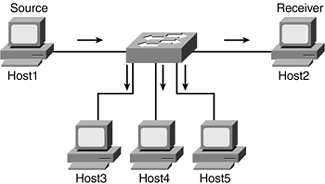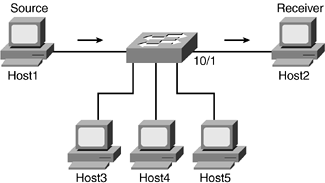Multicast Flooding
Because no specific host is associated with the multicast MAC address in the content-addressable memory (CAM) table, multicast traffic is flooded throughout the VLAN. (See Figure 9-1.) This type of setup creates unnecessary traffic on the VLAN and wastes precious network resources. Each host machine has to process the packet as it arrives on the interface card, thus, wasting CPU cycles. If the volume of the multicast stream is high enough, it could potentially cause other relevant and control traffic to be dropped. This problem worsens if the VLAN is extended to various other campus switches.
Figure 9-1. Each Host Receives the Multicast Stream

One easy method to address this problem is to manually map the ports that require the multicast traffic to the multicast MAC address. For example, Host2 on port 10/1 is interested in receiving the multicast stream 239.1.1.1 as shown in Figure 9-2.
Figure 9-2. Multicast Traffic Is Sent Only to Host2

To manually configure ports to receive the multicast stream, it is important to know how to derive the Layer 2 MAC address for the multicast group 239.1.1.1. The first 4 bits of the 32-bit address are defined as a Class D address (1110); now, only 28 bits of meaningful address space remain. A Layer 2 MAC address has 48 bits. The first 25 bits are static (01005e), leaving only 23 bits for the IP address to be placed. Because there are 28 bits of meaningful IP addresses, 5 bits must be thrown away to allow the remaining 23 bits to fit. As a result of the 5 bits thrown away, 32 multicast IP addresses (2^5) are mapped to a single Layer 2 MAC address.
The calculation in Figure 9-3 shows how to derive the Layer 2 MAC address for multicast group 239.1.1.1.
Figure 9-3. Calculating MAC Address for Multicast Group

Port 10/1 is configured to accept the 239.1.1.1 stream on VLAN 3. (See Example 9-2.) All other ports should not receive this traffic anymore because the CAM table has only one port associated with the multicast traffic. After the configuration change, the show mac command shows port 10/1 as the recipient for the multicast traffic.
Example 9-2. Creating a Static CAM Entry
Switch1 (enable) set cam static 01-00-5e-01-01-01 10/1 3 Static multicast entry added to CAM table. Switch1 (enable) show mac 10/1 Port Rcv-Unicast Rcv-Multicast Rcv-Broadcast -------- -------------------- -------------------- -------------------- 10/1 2 5 0 Port Xmit-Unicast Xmit-Multicast Xmit-Broadcast -------- -------------------- -------------------- -------------------- 10/1 1 13766 0 Port Rcv-Octet Xmit-Octet -------- -------------------- -------------------- 10/1 504 20684066
Realistically, manually associating ports with specific multicast streams is not a viable option. Each time a new multicast stream is generated, manual intervention is required to configure specific ports to receive the traffic. In a different situation, if Host3 now wants to receive 239.1.1.1 traffic or Host2 no longer wants the traffic, this, too, must be manually configured. Multicast support on a switch needs to be efficient, dynamic, and relatively easy to implement.







